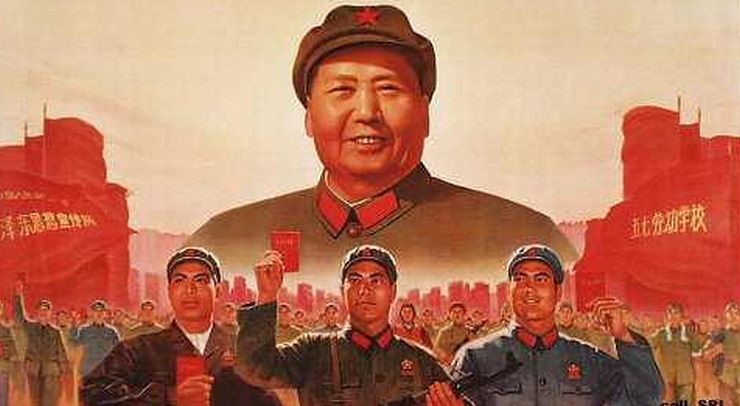
The spread of SARS-CoV-2 from the epicentre in Wuhan, China, has led to hundreds of thousands of COVID-19 cases around the world.
The medical community, governments, data analysts, and the general public rely on accurate data to make timely assessments and save lives.
But the accuracy of official data from the Chinese authorities is routinely questioned.
This explainer examines China’s official information transparency environment from a legal and historical perspective.
Control of information
Control of information in the People’s Republic of China has been a feature since its founding in 1949. Today, China’s State Secrets Law, which came into effect in 1989 and was revised in 2010, mandates that information be given a classification, with the charge of revealing state secrets and internal information carrying harsh criminal penalties.
Exactly what is considered to be classified is a state secret itself, and implementing regulations handed down to various government departments are not public.
However, many of these documents have been leaked, shedding light on the sweeping range of information the law covers, from data on death sentences and executions, use of organs from prisoners, and re-education plans for political and religious prisoners.
The law also classifies information on labour strikes, environmental contamination and pollution, and infectious diseases and epidemics.
China has an Open Government Information Regulation, which came into effect in 2008 and was revised in 2019.
This freedom-of-information law provides a right for members of the public to request records from the government and a remedy for the failure of disclosure.
Citizens have been successful in obtaining records, courts frequently rule in favour of government disclosure, and local governments have been more pro-active in making information publicly available.
The types of successful claims have involved data regarding government budgets, pollution, food and drug safety, land takings and compensation, government procurement, and law enforcement.
Although China’s open information law has improved local transparency and accountability environments, any records produced are subject to the State Secrets Law.
This means that information released on government websites and to the public is vetted in advance for anything the government does not want to be revealed.
In fact, a range of actors are permitted to classify information, including the Supreme People’s Court and Procuratorate, the Red Cross of China, and even state-owned enterprises.
If authorities can hold information and decide to classify it, what about information not produced or collected by government actors? In other words, what about journalists and private citizens who collect publicly available information?
News reports in China are subject to the State Secrets Law and must undergo an internal review process before publication.
Journalists must swear loyalty to the CCP to keep their credentials, and the number of investigative journalists has markedly declined under leader Xi Jinping, according to the NGO Freedom House.
The downfall of the reputable Southern Weekly publication after protests over censorship in 2013 was a particular blow to investigative journalism in China.
Citizen journalists in China are frequently arrested. Notably, three such individuals are currently incommunicado after reporting in Wuhan in early 2020: Chen Qiushi, Fang Bin, and Li Zehua.
Perhaps most notable is the case of Huang Qi, the founder of the 64 Tianwang website that publicised information about local corruption, criminal detentions, forced demolitions, petitioner activism, and public demonstrations.
In July 2019, he received a 12-year prison sentence after being picked up in 2016, shortly after receiving a prize from Reporters Without Borders.
The authorities routinely censor information and arrest political dissidents, but what about seemingly innocuous data released by the government itself? Is the data complete and reliable? Is it partial or fabricated?
Fabricated data
Researchers have demonstrated that China’s use of performance targets to incentivise local officials, a “key feature of China’s bureaucratic regime,” leads to inaccurate reporting.
In 2016, the Director of China’s National Bureau of Statistics, Ning Jizhe, wrote in the People’s Daily – the Communist Party’s official mouthpiece – admitting and condemning widespread falsification of local statistics.
This revelation followed questions in 2015 regarding the unusually stable reported GDP figures.
In 2018, Bloomberg economists Tom Orlik and Qian Wan found that provinces had overstated their GDP data between 2011 and 2015. By cross-referencing energy consumption with output data, the researchers showed that China’s statistics were “exaggerated” by fake data.
Missing citizens
China’s last census was in 2010, when the one-child policy was still in effect. The policy has resulted in families with more than one child not registering their additional children, as doing so subjects them to hefty penalties as well as potential consequences including forced sterilisation and abortions.
These “missing” citizens, therefore, lack official registration, cannot attend school and are ineligible for many government services.
The 2010 census revealed an estimated 13 million unregistered citizens, a figure which is equal to 1 per cent of China’s total reported population.
The government has acknowledged this data gap, most notably after the 2008 Sichuan earthquake. If a family lost their registered child, they were permitted to legalise an unregistered child without penalty.
Organ harvesting
Another instructive case is that of statistics regarding organ harvesting. China has admitted to using prisoners as sources of organs for medical purposes as early as 2005. The authorities promised in 2013 to end this practice, and they claimed to have stopped it in 2015.
However, in late 2019, Australian National University PhD researcher Matthew Robertson published research examining China’s reported organ harvesting data, finding that data sets match a simple mathematical formula, the quadratic function.
“It is difficult to imagine how this model could [have] been arrived at by mere chance, raising the distinct possibility that it was intended to deceive,” Robertson wrote.
The Red Cross of China is responsible for verifying and publishing organ donation data. So is the Red Cross compromised?
“Data” includes more than numbers and statistics; verifiable or agreed-upon facts are routinely disputed by China. This includes geographic boundaries, such as the South China Sea dispute and China’s regulations regarding printing and distributing “correct maps.”
But arguably political issues aside, which are official statistics intentionally falsified? When are the problems attributable to poor collection and reporting methods? Does it matter?
These questions receive the most scrutiny when inaccurate data leads to preventable death, or data on deliberate human rights violations is concealed. A look at some major incidents in China’s recent history, and questions of data accuracy, is instructive.
Extrajudicial detentions in Xinjiang Uyghur Autonomous Region
Justified as counterterrorism and anti-extremism measures responding to unrest in Xinjiang in July 2009, China has incrementally increased control and surveillance over citizens in the autonomous region, leading to reports in 2017 of mass extrajudicial detention of ethnic minorities.
In 2018, multiple, independent studies have each arrived at credible estimates of one million people in these detention centres, based on data including satellite images of facilities, analysis of floor plans, studies of public procurement documents, criminal arrests in the region, and government budgets and spending documents.
China initially denied the existence of such facilities, but later justified them as voluntary “re-education” camps.
In November 2019, the New York Times published 24 leaked internal documents, including speeches and directives from China’s leaders, which revealed not only the scope of surveillance and control in the region but also the intent behind it.
Later that month, another trove of leaked, classified documents obtained by the International Consortium of Investigative Journalists revealed the mechanics of the facilities’ operations.
The documents are directives on preventing escapes, maintaining secrecy about the facilities’ existence, controlling the outbreak of disease, and preventing unnatural deaths.
The Chinese government responded to the leaks by stating: “There are many authoritative documents in China for reference of Chinese and foreign media who want to know more about the vocational education and training centres. For instance, seven relevant white papers have been published by the State Council Information Office.”
None of the white papers contains information about the number of citizens subjected to the programmes, nor do they refute claims about the nature of the facilities or intent of the plan.
Wenzhou Train Crash
On July 23, 2011, two high-speed trains on the Yongtaiwen railway line collided on a viaduct outside the city of Wenzhou, killing 40 people and injuring 191, according to official figures.
The official report, released in December 2011, cites a lightning strike that confused train signals as well as construction issues and contract bidding irregularities. But rather than reveal details of the accident to the public, the report’s purpose is to blame and punish 54 named officials.
Eight hours after the crash, officials ordered the rescue effort be concluded and the train cars were buried. However, a video circulated online shows bodies falling from the train cars as they are moved, and a child was found alive hours after rescue efforts were halted. Even days later, bodies continued to be discovered.
As online calls for the truth rang out, the authorities gave strict directives to the media, leaked online and published by China Media Project. The first directive is: “Figures on the number of dead must follow numbers from authoritative departments.”
Authorities also demanded that news stories should focus on positive news, and journalists should not investigate the causes of the accident or provide commentary.
Sichuan earthquake
On May 12, 2008, China experienced a 7.9-magnitude earthquake with an epicentre in Wenchuan, northwest of Chengdu in the Sichuan Province.
State media reported over 65,000 deaths in late May, with the figure increasing to almost 90,000 after those previously considered missing were presumed dead.
China reported 5,335 student deaths – attributed to shoddy construction of village schools – but never released a list of victims. Relatives of those who died faced harsh repercussions for seeking answers, according to a report by Amnesty International.
Indicative of ongoing lack of trust in government data, public suspicion was raised after an official made a speaking error in November 2008. When reporting on the figure of 19,065 identified victims, Sichuan Provincial Vice Governor Wei Hong mis-stated that number was total student deaths. Observers questioned whether this was an accidental revelation of the true figures the government held.
Many citizens have faced criminal penalties for gathering their own information regarding earthquake casualties.
Notably, Liu Shaokun was detained in June 2008 and ordered to serve one year of re-education through labour for taking photos of collapsed buildings and giving media interviews, and Tan Zuoren served a prison sentence after attempting to compile a list of students who had died in the earthquake. Huang Qi and Ai Weiwei are other notable figures penalised for their investigations.
SARS outbreak
SARS-CoV-1 broke out in November 2002 with a patient in Foshan, Guangdong Province. Ultimately, 8,098 cases were reported worldwide, with 774 deaths.
China reported 5,327 cases and 349 deaths (fatality rate of 6.6 per cent). Hong Kong saw 1,755 cases and 299 deaths (17 per cent), and the worldwide data excluding China is 2,769 cases and 454 deaths (16.4 per cent).
Jiang Yanyong of the People’s Liberation Army General Hospital (Hospital 301) came forward after China’s health minister Zhang Wenkang stated on April 15, 2003, that Beijing had only 12 cases and 3 deaths. Jiang publicly refuted this claim, revealing that over 60 patients were admitted and 7 had died in one Beijing hospital alone, and another hospital was “already full to capacity” at the time of the official statement.
On April 3, 2003, authorities admitted that their communication of information with the WHO was not timely and vowed to improve in the future.
The then-director of China’s Centre for Disease Control, Li Liming, apologised: “We weren’t able to muster our forces in helping to provide everyone with scientific publicity and allowing the masses to get hold of this sort of knowledge.”
Tiananmen Square crackdown
After weeks of pro-democracy demonstrations in Beijing and across the country, the night of June 3, 1989 was one of bloodshed.
Yuan Mu, spokesperson of the State Council stated on June 6, 1989, that there were no deaths in Tiananmen Square, contradicting his earlier claim that 300 people, including 23 university students, died in the incident.
Infamously, in an interview on June 17, 1989, with NBC’s Tom Brokaw, Yuan Mu elaborated: “I didn’t say that no casualties resulted from our efforts to put down the counter-revolutionary rebellion. I only said that no one died when the PLA cleared Tiananmen Square.”
Professor Andrew J. Nathan at Columbia University, co-editor of The Tiananmen Papers, a publication of leaked internal documents, wrote of Beijing Party Secretary Li Ximing’s statement to the Politburo on June 19, 1989, that 218 civilians died: “Mr Li was reporting what the Politburo wanted to hear, and it may not have been the truth. But we have no other material… against which to check it.”
Estimates of 400-800 civilian deaths are accepted, but some estimates range into the thousands. Recently declassified cables from the United Kingdom claim a CPC estimate of 10,000 deaths. The Chinese Red Cross made a statement, later retracted, of 2,700 deaths.
The Tiananmen Mothers, a group of families of the victims, has worked for three decades to identify victims. Members of the group have travelled to remote locations, collecting stories, memories, photos, and information from families. Each year, they press for state compensation, accountability, and the truth.
The Tiananmen Mothers have identified 202 victims, and the stories reveal that not only students and demonstrators, but also workers and passersby, were indiscriminately shot on June 3 and into the morning of June 4.
Furthermore, families describe hospitals refusing to write the true causes on death certificates, bodies hastily disposed of in shallow yards and reluctance and fear over being identified.
According to records of the Hunan provincial government obtained by the Dui Hua Foundation, 1,602 individuals were convicted and sentenced across China for activities related to the pro-democracy movement in the spring of 1989.
On the eve of the 30th anniversary of the incident, a government spokesperson called the crackdown “correct.”
Cultural Revolution and other campaigns of Mao Zedong
With the founding of the People’s Republic in 1949 under the leadership of Mao Zedong, more than a dozen campaigns lasting until his death in 1976 led to the unnatural deaths of millions of Chinese citizens.
Most commonly referenced are the Great Leap Forward and the Cultural Revolution, which were responsible for the deaths of millions due to famine and political targeting.
In addition, other campaigns targeted landowners, “counter-revolutionaries”, Nationalist sympathisers, and Christians.
The invasion of Tibet in 1950, and the crackdown after the Tibetan uprising in 1959, led to hundreds of thousands or perhaps millions of deaths from violence, as well as starvation and repression in detention.
Official figures on deaths are difficult to come by, as accurate records may not have been kept, were lost during the upheavals in question, or are still classified. Death reports, in particular, are inaccurate as starving families did not want to lose that individual’s rations.
According to a 1978 report of the CPC Central Committee, 20 million citizens died, 100 million were persecuted, and 800 billion yuan lost.
Subsequent and extensive research has led to figures as high as 80 million deaths, but 40 million is commonly accepted.
Similarly, economic data during this time is inaccurate. The central authorities set highly unrealistic performance targets for local officials, leading to over-reporting on the local level.
So how do you want to believe such a nasty gang of deadly clowns. Don’t be fools! More alternative headlines on Strange Sounds and Steve Quayle. [HongKong Free Press]












Coronavirus resurgence possible as late as 2024, Harvard study says
If immunity to the virus is not permanent, it is likely to enter into regular circulation, similar to the flu.
By LEON SVERDLOV APRIL 15, 2020 09:21
Email Twitter Facebook fb-messenger
Healthcare workers wheel the bodies of deceased people from the Wyckoff Heights Medical Center during the outbreak of the coronavirus disease (COVID-19) in the Brooklyn borough of New York City, New York, U.S., April 4, 2020 (photo credit: REUTERS)
Healthcare workers wheel the bodies of deceased people from the Wyckoff Heights Medical Center during the outbreak of the coronavirus disease (COVID-19) in the Brooklyn borough of New York City, New York, U.S., April 4, 2020
(photo credit: REUTERS)
Social distancing may be required until 2022 to prevent critical care capacities from being exceeded, said a Harvard study published in the journal Science on Tuesday as more coronavirus patients are hospitalized in intensive care units.
“Even in the event of apparent elimination, SARS-CoV-2 surveillance should be maintained since a resurgence in contagion could be possible as late as 2024,” the scientists said in their report.
The study was conducted by Stephen M. Kissler and Yonatan H. Grad from Harvard’s Department of Immunology and Infectious Diseases, as well as Marc Lipsitch, Christine Tedijanto and Edward Goldstein from the university’s Epidemiology department. Grad and Lipsitch are corresponding authors of the report.
Regardless of the transition dynamics of the virus, say the scientists, urgent measures should be taken in order to address the current pandemic. “Vaccines and pharmaceutical treatments may require months to years to develop and test,” say the scientists, with the only way to curb the pandemic being non-pharmaceutical interventions.
According to the scientists, SARS-CoV-2, the virus causing the deadly COVID-19 disease, is capable of producing a “substantial outbreak” regardless of the season in all modeled scenarios.
The study found that outbreaks established in the winter-spring, like the one leading to the COVID-19 pandemic, tend to have lower peaks. Ones occurring in the autumn-winter, on the other hand, are more acute, said the scientists.
It has yet to be determined whether people once infected would be permanently immune to the virus. According to the study, if immunity to the virus is not permanent, it is likely to enter into regular circulation, similar to pandemic influenza (the flu).
It is likely that short-term, 40-week immunity to the virus will lead to annual coronavirus outbreaks. If the immunity is long-term, standing at two years, the outbreaks will likely be biennial, with a major coronavirus outbreak occurring every other year.
As of Wednesday morning, the mortality rate of the COVID-19 disease stands at 6.4%, with close to 127-thousand deaths of nearly two million confirmed cases. By contrast, the mortality rate of the flu in the US stood at stood at 0.096% in the 2018-2019 season, according to the Centers for Disease Control and Prevention (CDC), being nearly 67 times lower than that of the coronavirus.
A 2006 study published by the CDC’s Emerging Infectious Diseases journal estimates the mortality of the Spanish Flu between 10-20%. Epidemiologist Larry Brilliant, who worked with the World Health Organization to help eradicate smallpox, told CNN late March that the 1918-1919 pandemic’s mortality was between 2-10%.
According to the Harvard researchers, even if SARS-CoV-2 immunity will only last for two years, mild, 30%-immunity from other existing strands of coronavirus that usually cause the common cold may effectively eliminate its transmission for up to three years.
Even if the virus does appear to have died out, say the scientists, a resurgence in 2024 is likely. According to the Harvard researchers, long-term immunity, one achieved by vaccination, could potentially lead to the elimination of the virus.
China is Ayatollahs States and no freedom of press or religion or anything, they condition them to accept fascism or go to fema camp taring . So now all world is communist nations because they have made us to do things we never do, freedom human rights, is something no one can give up, but with name of Corona they shoved in our throat and we accepted it. India Muslim disobeyed the curfew came in 100,000 and clashed with police uses corona to scare people. This is a global experiment going on?
organ harvesting, especially of black people, is global and not just china. america is behind much of it. pin the tail on the donkey instead of blaming others. we have the same problems as everyone else. it doesn’t make ours go away to point out those of everyone else. statism is dead. we are dealing with a global elite that do not care about borders anymore.